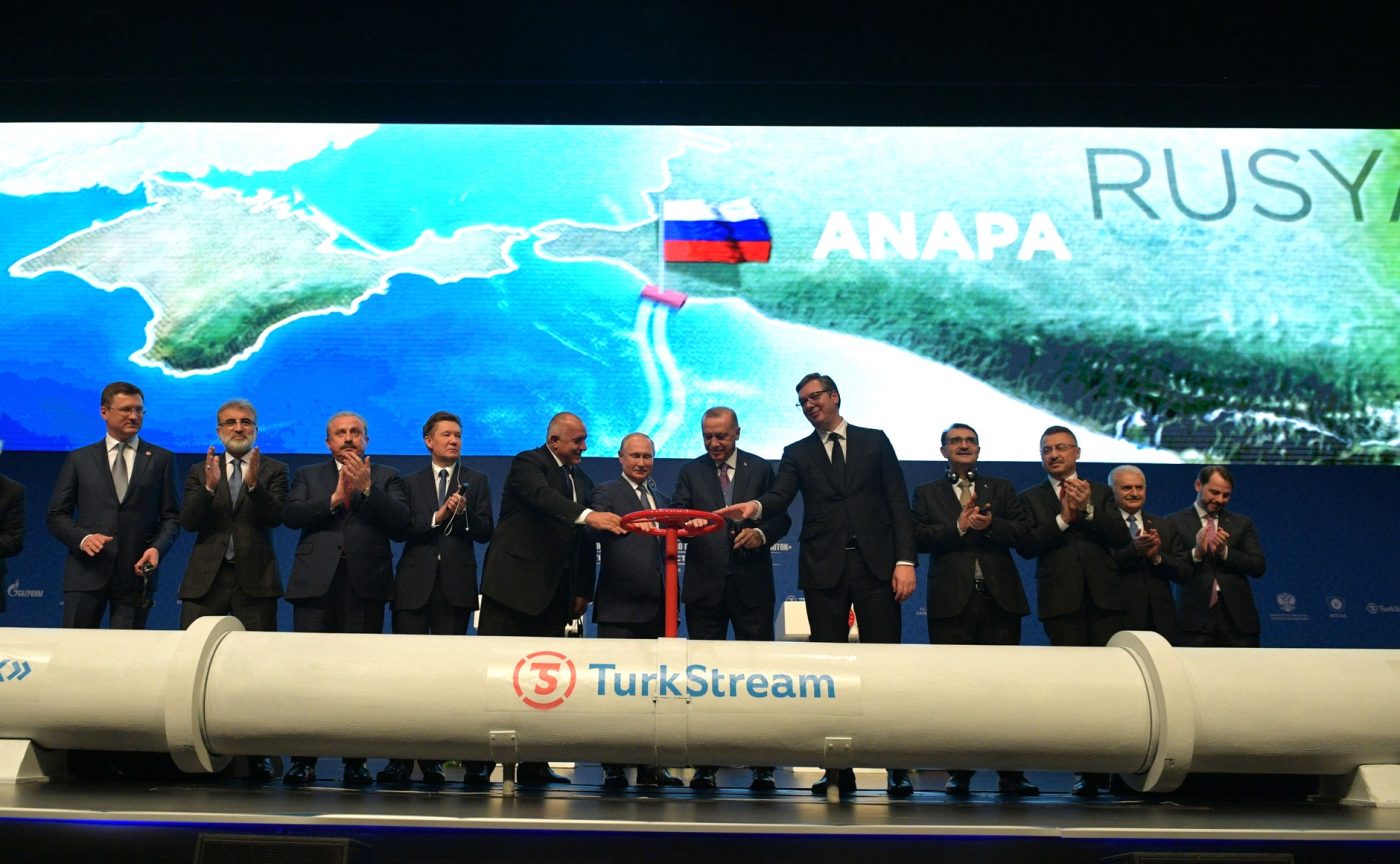TurkStream avoided the fate of Nord Stream 2 only because it was completed one month before the U.S. sanctions against both pipelines came into effect. The new Russian pipeline through the Black Sea to western Turkey was inaugurated on January 8 at a lavish ceremony in Istanbul, in the presence of Turkish President Recep Tayyip Erdoğan, Russian President Vladimir Putin, Serbian President Aleksandar Vučić, and Bulgarian Prime Minister Boyko Borisov.
But so far TurkStream is only used at less than half capacity. It came online at a time of drastic changes in the European gas market. These changes were not beneficial for Russian oil and gas companies, even before Putin’s gaffe with OPEC that sunk global oil prices.
First, increased liquefied natural gas (LNG) supplies have replaced a sizeable share of Russian pipeline gas in the markets of both the European Union and Turkey.
Secondly, the abundance of LNG has driven European gas prices to a historic low level, pushing down Russian gas prices as well.
Third, building new infrastructure for alternative gas supplies to Turkey and the Balkans has accelerated: the Southern Gas Corridor from Azerbaijan to Italy, passing through Turkey and the Balkans, is scheduled for completion this year, while plans for new LNG regasification facilities in the region are advancing.
Two consecutive warmer winters in Asia have depressed gas demand in the Asian markets and led to the diversion of vast quantities of U.S. and Australian LNG to the European continent. LNG supplies to Europe have doubled since 2017, surging to 123 bcm in 2019, and are likely to reach 136 bcm (100 million tons) in 2020. This resulted in Russia being unable to sell all of its European-bound gas supplies to end-users last year. In fact, 15% of Gazprom gas transmitted to Europe in 2019 was stockpiled in storage facilities in the Netherlands and Austria in transactions backed by Gazprombank. This prompted Russian newspapers to comment that Gazprom has started selling gas to itself. Gazprom’s exports to Germany, its biggest market, have declined by almost 9%. And Turkey has reduced Russian gas deliveries even more dramatically, with Italy replacing it as Gazprom’s second-largest buyer.
According to Gazprom’s financial statements, Europe today pays the lowest prices in 15 years for Russian gas. In the third quarter of 2019, the price of Russian natural gas averaged $169.80 per thousand cubic meters, down from $250.80 last year. This dramatic price drop is related mostly to low European spot prices, which are currently under $3 per million metric British thermal units (BTU), down from $8-9.5 in fall 2018. Russian gas prices have followed that trajectory, dipping in January to half that price a year earlier.
In addition, Gazprom’s long-term contracts are now tied to spot prices, ever since the European Commission completed its anti-monopoly probe of the Russian gas giant and mandated significant changes to existing contracts. The last country to renegotiate its contract with Gazprom was Bulgaria, which received a 40% retroactive gas price drop this month. But Sofia may expect even deeper gas discounts after the oil prices dropped this week as gas prices are still indexed by oil prices in the renegotiated contract.
TurkStream is designed to deliver 33.5 bcm of natural gas – half of which is intended for the Turkish market while the other half is slated for the Balkans and further to Central Europe. However, in January, the pipeline delivered only 1.15 bcm of gas to Turkey and Bulgaria and the next few months do not look more promising. As Gazprom was hurrying to build the new $12 billion pipeline, Turkey drastically decreased Russian gas imports by 40% compared to 2018. It switched to Azerbaijani gas as soon as the Southern Gas Corridor became operational on its territory, bumping its share by 29%. Ankara has also boosted LNG deliveries, which now comprise a quarter of total gas imports.
More importantly, Gazprom so far lacks the infrastructure to transmit natural gas beyond Bulgaria, because the extension of TurkStream through the Balkans has not been built. When eventually completed, the new pipeline on EU territory will have to comply with the EU’s Gas Directive and reserve capacity for alternative gas suppliers. Thus, Gazprom will not be able to use the entire 15.75 bcm capacity of the prospective Balkan Gas Hub in Bulgaria.
The Kremlin launched Nord Stream and TurkStream as diversionary pipelines with several goals: to bypass Ukraine, compete with alternative gas suppliers (such as the Southern Gas Corridor and LNG), divide EU member states into supporters and opponents of Russia’s new mega pipeline projects, and obstruct and undermine EU laws, mainly its energy regulations.
TurkStream is proving to be an investment failure by Moscow, which according to experts will take 47 years to become profitable. However, it managed to bypass Ukraine as a transit state: the Trans-Balkan pipeline from Ukraine to Moldova and Romania has effectively become redundant and will be used in reverse for Russian gas deliveries from TurkStream to the Balkans. It will be up to the European Commission to enforce its laws and not allow Moscow to fully achieve its objectives in the energy sector of the Balkans.
Europe’s Edge is CEPA’s online journal covering critical topics on the foreign policy docket across Europe and North America. All opinions are those of the author and do not necessarily represent the position or views of the institutions they represent or the Center for European Policy Analysis.





